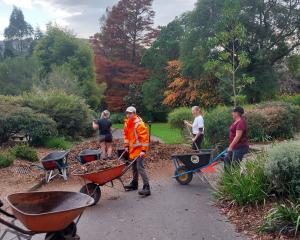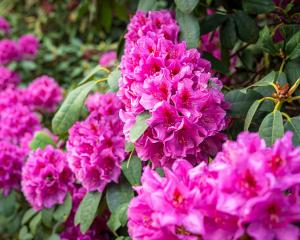A South Australian garden, Al-Ru, is a surprising oasis of green, as Gillian Vine finds.
A peacock drifts across a lush lawn, pauses long enough to be photographed then heads into the shrubbery. Everything is so green and fresh, it doesn't feel like South Australia. Yet Al-Ru Farm is tucked into the Adelaide Hills, halfway between the city and the Barossa Valley.
The half-hour journey from Adelaide is through dry countryside, so Al-Ru's greenness is slightly disorientating. If one ignores the eucalypts and concentrates on the olives, it's easy to imagine this is France, not Australia.
The Mediterranean look is deliberate. After Ruth and Alan Irving bought the property in 1981, she set out to turn the ground around the homestead into a garden reminiscent of the French countryside.
From the colonnade by the pond to bearded irises and roses reminiscent of Monet's garden in Normandy, the garden looks more European than antipodean. Appropriately, the climbing roses on the arches leading to the formal garden are French - the sweet-scented Pierre de Ronsard, which does particularly well in South Australia.
Ruth, who describes gardening as ''the hardest art'', has used an approach similar to that of a painter to get the maximum effect from the 4ha area.
Unlike many larger gardens, this is not achieved by repetitious planting but by harmonious changes every 2m or so. These are so subtle and skilled there is a gentle flow from one area to the next.
''This `layered level' [approach] is for me one of the challenges - and the joy and frustration,'' Ruth said.
There's nothing static about her approach, either, for the garden looks different in each season.
''I have a garden that changes its demeanour every two weeks from early August,'' Ruth said.
She started with very little - ''a couple of King Alfred daffodils, calendulas, a bit of lawn and a huge rubbish tip out the back'' - added a rose garden and, after reading books by influential Australian landscaper Edna Walling (1895-1973), was convinced a pond was needed.
After that, ''like Topsy, it just grew''.
Although she picked up ''by osmosis'' what her parents had done, at that stage Ruth says she did not have the design skills she has since developed.
''There's a bit more cohesion now.''
The garden flows out from the house, so the lawn - accessed from the colonnaded verandah - is, in summer, treated as an outdoor living room.
European trees - oak, ash and elm - surround the lawn, giving shade to plants underneath as well as an illusion of coolness, even on the hottest days. Ruth and her mother planted them all and it is difficult to imagine the garden without this all-important feature.
The flowering year starts with hellebores, snowdrops, bluebells, pink silene and lime euphorbias; then campanulas, giant poppies and geranium species kick in. Asters, helianthemums and the see-through verbena (Verbena bonariensis) take over before the soapwort
and a selection of sedums come into play.
Although mauve is the anchor colour, there is plenty of yellow, including variegated privet, a non-invasive double buttercup, Achillea Golden Plate, Kniphofia Little Maid and Hemerocallis Yellow Kitten.
Ruth is not afraid of orange, as the bright beacons of Kniphofia Winter Cheer demonstrate, while hollyhocks include lots of red and pink spikes. Left to self-seed, the colour of the latter determines whether they will go or stay.
Silver is also important as a balancing colour and although Ruth dislikes the ''nasty great fat thorns'' of the Russian olive (Elaeagnus angustifolia), it has ''fabulous silver foliage''.
So, too, does cardoon, more often found in vegetable beds but ideal in a dry border, while treading the line between green and silver is pride of Madeira, Echium candicans Al-Ru. Bred here, it has silvery leaves and spires of mauve-blue flowers held well above the foliage.
The echium not only looks good but is a favoured butterfly plant, important to Ruth, who has a butterfly breeding programme.
Despite the fantastic show, it would be a mistake to think anything will grow at Al-Ru, even with the generous amount of water the Irvings have available. Camellias and paeony roses cannot be grown here and a handkerchief tree (Davidia involucrata) died, so Ruth concentrates on what does best - poppies instead of paeonies and a quince instead of trying another Davidia.
''I do the `'nstead of' approach,'' she said.
And, as any visitor to Al-Ru will agree, it works brilliantly.
In South Australia, Gillian Vine was the guest of the South Australian Tourism Commission.
See it
Al-Ru Farm, One Tree Hill, South Australia, is part of the Australian Open Garden Scheme and is open on selected occasions.
For details or to book bed andbreakfast accommodation at Al-Ru, visit alru.com.au











